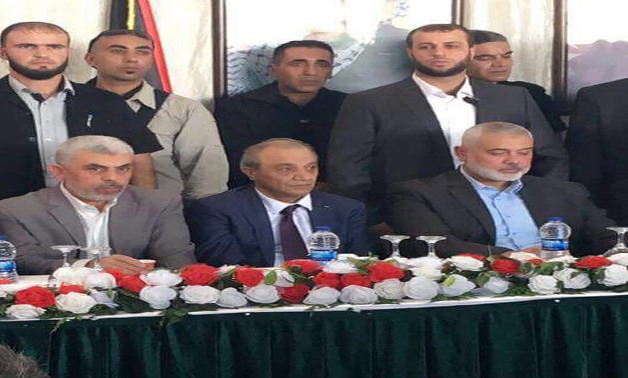
Hamas and Fatah delegations together at Ahmed Hillies's House in Gaza - File Photo
CAIRO – 2 October 2017: October 2 represents a turning point in modern Palestinian history, as it marks the end of a decade long internal split and dispute among rival factions Hamas and Fatah.
Since Hamas announced the dissolution of its administrative committee in the Gaza Strip on September 17, Palestinians held their breaths and anticipated that the reconciliation claims will fail as it failed many times before during the last 10 years.
Some Palestinians even went on to describe the reconciliation news as a “Turkish Soap Opera” that never ends and dealt with the news as another episode in this series.
Optimism found its way to Palestinians only when Hamas invited the national consensus government prime minister, Ramy al-Hamdallah, to visit Gaza and assume his duties in the Strip. Hamas also called for holding general elections in Palestine and confirmed complying with the Cairo reconciliation accords of 2011. Palestinians became even more optimistic and ambitious when Egypt announced overseeing the implementation of the national reconciliation, which reached its highest level when an Egyptian delegation arrived to Gaza on Sunday and was received by the head of the Hamas movement, Ismail Haneyah.
On October 2, the dream came true and a new chapter started in the relations between the West Bank and the Gaza Strip, as the national consensus government, formed in June 2014, arrived in Gaza, and delegations of Hamas and Fatah met together and announced prioritizing Palestine over factions.
Palestinians expressed their joy and hope of a better future for the Gaza Strip that is living under blockade and international isolation and has suffered the devastating results of three Israeli escalations since 2007. Their dreams and wishes ranged between receiving 24-hour electricity, better education, meeting their friends and relatives that live outside of the Gaza Strip, to opening the borders so that they can move freely from and to the Strip.
Palestinians’ optimistic mood was portrayed in their social media posts. Some Palestinians in Gaza also started painting the walls and fences outside Mahmoud Abbas' abandoned official residence, and a Palestinian flag with the government logo was painted on the front door. On a main downtown street, a huge poster of Abbas and Hamdallah hung outside a souvenir store. "Welcome to Palestine's beating heart: glorious Gaza," it said.
Many hashtags were launched to mark this occasion, including hashtags that translate to “I am with reconciliation”, “the reconciliation,” and “Our Unity is Our Power.”
Palestinian youth draw a message on Gaza’s beach sand – “Our Unity is Our Power.”
“Hand in hand, one homeland, one Palestine.”
On October 3, the consensus government will hold its first cabinet meeting from Gaza. The consensus government is expected to form a number of ministerial committees to address the effects and consequences of the internal division as well as other civil, administrative and legal issues arising from the split.
Hamas official Mushir al-Masri said that Hamas and Fatah will continue their talks in Egypt in the coming weeks to work on a final deal.
Despite a number of attempts to reconcile the Palestinian split, led by international and Arab efforts, only Egypt, with its historical and political position, was able to bring an end to this nightmare. Egypt managed to bring the conflicting Palestinian factions to overcome the obstacles and to invest the opportunities to create new conditions away from the fear of exclusion. Egypt helped the factions realize that they need to move forward towards a partnership based on the fact that Palestine is for all Palestinians.

Comments
Leave a Comment